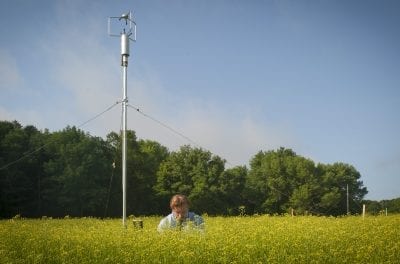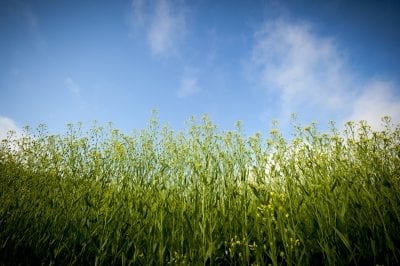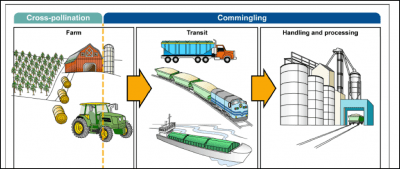Introduction to Plant Gene Flow

The movement of novel DNA sequences from genetically engineered (GE) crops to other plants has attracted attention because of its potential economic, ecological, and societal impacts. Gene flow is defined as a change in the genes of a particular group of plants due to the movement of pollen, seed, or live plants carrying modified DNA sequences (transgenes). The potential for gene flow, also called outcrossing, varies tremendously based upon the reproductive biology of each crop, the proximity of closely-related plants, wind patterns, the activity of pollinators, and many other factors. Because of this complexity, it is often difficult to predict the rate of gene flow between a GE crop and its neighboring crops, closely-related weeds, or wild plant relatives. However, understanding gene flow is critical to supporting coexistence — the simultaneous cultivation of GE, conventional (non-GMO), organic, and indigenous crops in accordance with the choices of farmers and consumers.
Crop species vary in their potential for gene flow. Sweet corn and field corn are susceptible to pollen-mediated gene flow because the male flowers release lots of pollen that is carried on the wind. Two neighboring farms may observe crop-to-crop gene flow if one farm has GE corn and the other has non-GMO corn. In this scenario, simultaneous flowering and the release of wind-blown pollen could allow the development of some hybrid GE seeds in the non-GMO corn field.
Alfalfa is another valuable crop that is susceptible to gene flow because its flowers attract bees that will carry pollen between plants. For alfalfa, pollinator

abundance and activity play a major role in gene flow. In contrast to corn and alfalfa, the likelihood of gene flow is relatively low in self-pollinating crops (eggplants, peppers, tomatoes, and beans) and vegetatively propagated crops (potatoes).
Research has shown that some native or non-native plants in the US can exchange genes with specific crops such as sunflowers, carrots, sorghum, rapeseed, and wheat. Scientists have studied this type of gene flow because transgenes and novel traits might change wild plant survival, natural plant communities, or ecosystem services over time.
Effects of Gene Flow
In the past 20 years, gene flow from GE crops has created challenges for coexistence between farming systems, the maintenance of genetic purity for seed lines, and other aspects of food production. The economic impact of unexpected and unwanted gene flow has been clearly demonstrated in US rice. In the Southern US, gene flow in the early stages of rice seed production caused the accidental incorporation of a transgene for herbicide resistance in a conventional variety (cultivar) of rice seed. After the rice harvest in 2006, the unapproved herbicide resistance trait was detected in stored rice as well as processed food products. This led to a decrease in the price that farmers could get for their harvested rice, and US rice exports were temporarily blocked by some countries. Many lawsuits were filed, and the biotechnology company paid $750 million dollars to about 2,500 rice farmers to compensate for their economic losses (July, 2011). These events illustrate the importance of a proactive approach to understanding and managing gene flow in industrial agriculture and food processing.

Managing Gene flow
The good news is that plant gene flow can be managed through a combination of containment strategies, cooperation, and communication. For example, when corn fields are physically separated by greater distances, they are less likely to have pollen drift and gene flow. Gene flow can also be reduced when corn fields flower and release pollen at different times in the summer. Bags of seed can be tested before planting to certify the presence/absence of specific DNA sequences. The US Department of Agriculture has produced fact sheets that provide more guidance on preventing gene flow (https://www.usda.gov/topics/farming/coexistence/coexistence-factsheets).
By Carol Auer, Professor Emeritus, UConn Department of Plant Science and Landscape Architecture
Published October 3, 2017